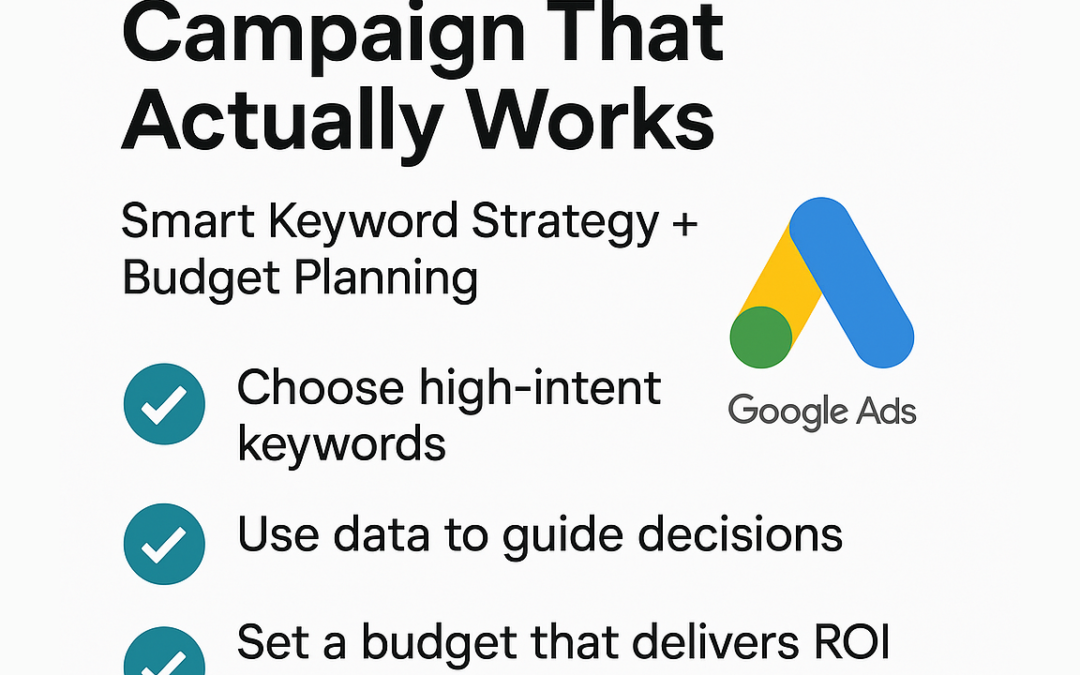When it comes to running a successful Google Ads campaign, two things matter most: choosing the right keywords and setting a realistic budget that leads to actual results. Too often, businesses waste money on keywords that never convert—or underfund their campaigns and get little to no traction.
This guide walks you through a practical, tested approach to choosing keywords that convert and setting a budget that supports growth, not guesswork.
1. Choosing PPC Keywords That Actually Convert
Picking keywords isn’t about grabbing the ones with the highest search volume. It’s about understanding user intent and targeting the terms most likely to lead to sales.
High-Intent vs. Low-Intent Keywords
-
High-Intent (e.g., buy espresso machine online): These users are ready to buy. Yes, they cost more—but they convert more.
-
Low-Intent (e.g., best espresso machine for home): These searches often come from people still researching. Good for awareness, but don’t expect conversions right away.
Match Type Strategy That Actually Works
Understanding match types helps control where your budget goes:
-
Broad Match: Too loose. Use carefully or with strong negative keywords.
-
Phrase Match: A middle-ground—flexible but still somewhat targeted.
-
Exact Match: Most focused. Best for high-intent keywords that drive action.
Expert Tip: Run separate ad groups for different match types. Monitor performance individually and shift budget toward what’s working.
Use Negative Keywords—Always
Negative keywords help cut waste by blocking unqualified traffic. For example, if you’re selling premium coffee machines, block terms like:
-
cheap coffee machines
-
DIY espresso maker
-
repair espresso machine
Pro Move: Build out your negative keyword list early—and update it weekly as new data rolls in.
2. Let Data Guide Your Keyword Choices
Gut feelings don’t work here. The best keyword strategies are built on actual data.
Use Google Keyword Planner and Third-Party Tools
Start with:
-
Google Keyword Planner – For volume and CPC estimates.
-
SEMrush or Ahrefs – To uncover keyword gaps, long-tail opportunities, and real competition levels.
Long-Tail Wins: Keywords like best small batch espresso machine for office often have less competition and higher conversion rates.
Watch What Competitors Are Doing
Tools like SpyFu, SEMrush, or iSpionage let you see:
-
What keywords competitors are bidding on
-
How much they’re likely spending
-
Which ad copy they’re using
Don’t copy—improve. Use this data to fill in gaps or outsmart their approach.
3. Set a Budget That Delivers Real ROI
This is where many campaigns fail: not spending enough to gather real performance data, or spending too much on the wrong clicks.
Budget Based on Math—Not Hope
-
Know Your CPA (Cost Per Acquisition): Let’s say a good lead is worth $50 to you.
-
Conversion Rate Estimate: At a 5% conversion rate, you’ll need 20 clicks per lead.
-
CPC Example: If clicks cost $2.50, your budget needs to be $50/day to make one sale.
Start with a Real Test Budget
-
$1,500/month is the minimum for meaningful testing in most industries.
-
Split spend across multiple ad groups, not just one.
Budget Allocation Example
-
Branded Keywords (10–20%) – Protect your brand name in search results.
-
Competitor Keywords (10–15%) – Target rival terms, but watch costs closely.
-
High-Intent Keywords (50%) – The core of your campaign. These drive conversions.
-
Testing & Expansion (15–20%) – Experiment with new keywords and audiences.
4. Avoid These Costly PPC Mistakes
1. Not Testing Enough
Always test multiple ad versions. Try different:
-
Headlines
-
Calls-to-action
-
Landing pages
Keep what works. Kill what doesn’t.
2. Blind Trust in Smart Campaigns
Google’s automated bidding and campaign suggestions can help—but only when monitored closely.
-
Set manual bid caps.
-
Watch actual search terms weekly.
-
Override or adjust when necessary.
Advanced Tip: Use Portfolio Bid Strategies combined with ROAS or CPA targets—but only after 30–60 days of stable data.
3. Ignoring Quality Score
Google uses Quality Score (1–10) to decide how often and how cheaply your ad runs.
Improve your score by:
-
Writing ads that match the keyword.
-
Making sure your landing page speaks directly to what the user searched for.
-
Speeding up your mobile site.
Higher Quality Score = Lower CPC + Better Ad Placement
5. Final Takeaway
PPC doesn’t have to feel like gambling. The businesses that win aren’t the ones spending the most—they’re the ones spending smart.
By:
-
Choosing high-intent keywords
-
Using match types and negative keywords strategically
-
Letting data guide decisions
-
Setting a real-world budget based on your CPA goals
You can build campaigns that convert consistently and scale profitably.
Bottom line: PPC isn’t magic—it’s math, strategy, and ongoing management. Treat it like a system, and it’ll pay you back.
